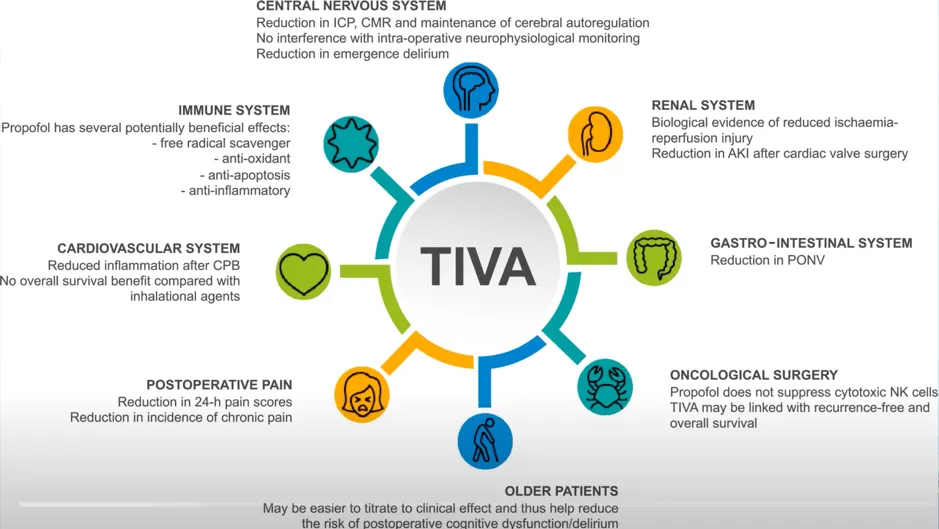What are the advantages of total intravenous anaesthesia (TIVA)? Total intravenous anaesthesia (TIVA) is the induction and maintenance of an anaesthetic state using only intravenous drugs, as opposed to a combination of intravenous drugs and gas inhalants. The advantages of total intravenous anaesthesia Propofol – based Total Intravenous Anaesthesia has a number of advantages including […]
Total intravenous anaesthesia (TIVA) is the induction and maintenance of an anaesthetic state using only intravenous drugs, as opposed to a combination of intravenous drugs and gas inhalants.
Propofol – based Total Intravenous Anaesthesia has a number of advantages including faster patient recovery.
Figure 12 demonstrates influence of propofol-based total intravenous anaesthesia on peri-operative outcome measures.

PONV is one of the most common causes of patient dissatisfaction after undergoing anaesthesia.3
The reported rates suggest that PONV occurs in 30% of all post-surgical patients and up to 80% of high-risk patients.3
TIVA has been associated with less PONV when compared to inhaled drugs. 4
Reducing the carbon impact of hospitals has become a higher priority for healthcare systems in recent years. By 2045, the NHS plans to eradicate or offset emissions that they can influence, with a goal to reach an 80% reduction by 2028-2032.10
Although the use of all anaesthesia equipment, drugs, gases and packaging comes with a carbon footprint, some inhalant agents have an additional greenhouse effect. Once exhaled, they continue to have a warming impact on the environment for many years.11
Desflurane is more potent than carbon dioxide, warming the atmosphere by the equivalent of at least 30-60kg of CO2 for every hour it is used.11
Due to this, in the Guide to Green Anaesthesia, TIVA is the recommended alternative to inhalation agents.12
The NHS is facing record-breaking waiting lists, with 6.73 million people awaiting treatment, 2.54 million of whom have already been waiting over the targeted 18 weeks for treatment.6 To help clear the backlog of patients, the NHS has been pushing the importance of day case procedures, targeting that hospitals should aim for 75%-day cases.7,8
Decreased risk of PONV can positively impact patients’ hospital stay, resulting in their faster discharge. In consequence minimising treatment costs and freeing up bedspace. Faster patient recovery reduces their time spent in Post Anaesthesia Care Unit.9
This could potentially allow hospitals to treat more patients daily and therefore tackle the growing waiting lists.
Using Mediplus TIVA sets support the already existing advantages of TIVA.
The anti-syphon valves on the drug delivery lines prevent backflow, whilst the non-return valves on the gravity lines prevent backflow as well as free flow. The red end caps are easily seen in breathing circuit.
The soft distal end provides minimal stress at the cannula site buffering any movement between patient and line.
Microbore tubing with small internal diameter reduces post-operative drug wastage whilst preventing kinking and line occlusion.
The Mediplus TIVA Sets include a wide range of infusion lines designed with Siamese tubing to reduce line entanglement.
Please find all the different configurations and lengths catering for everyone’s needs here.
References: